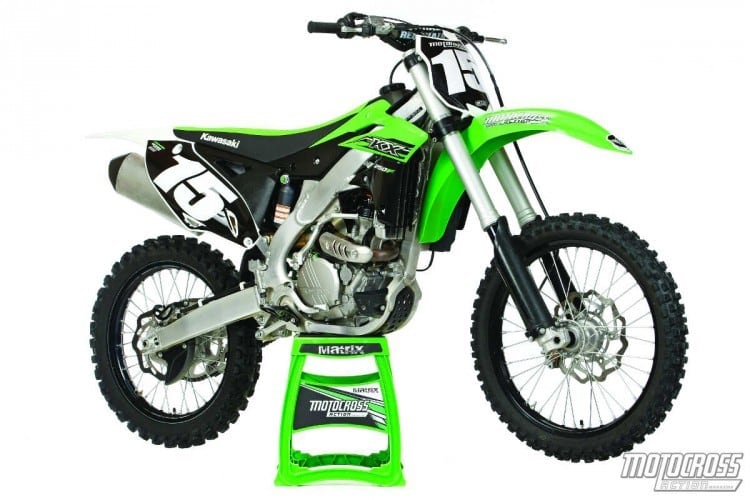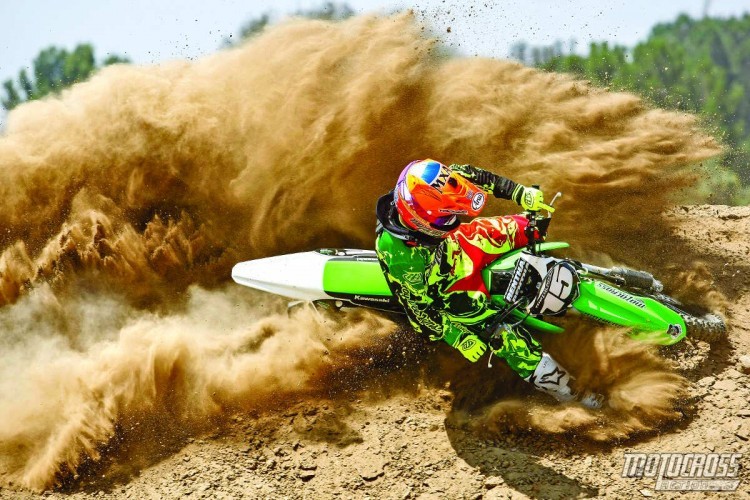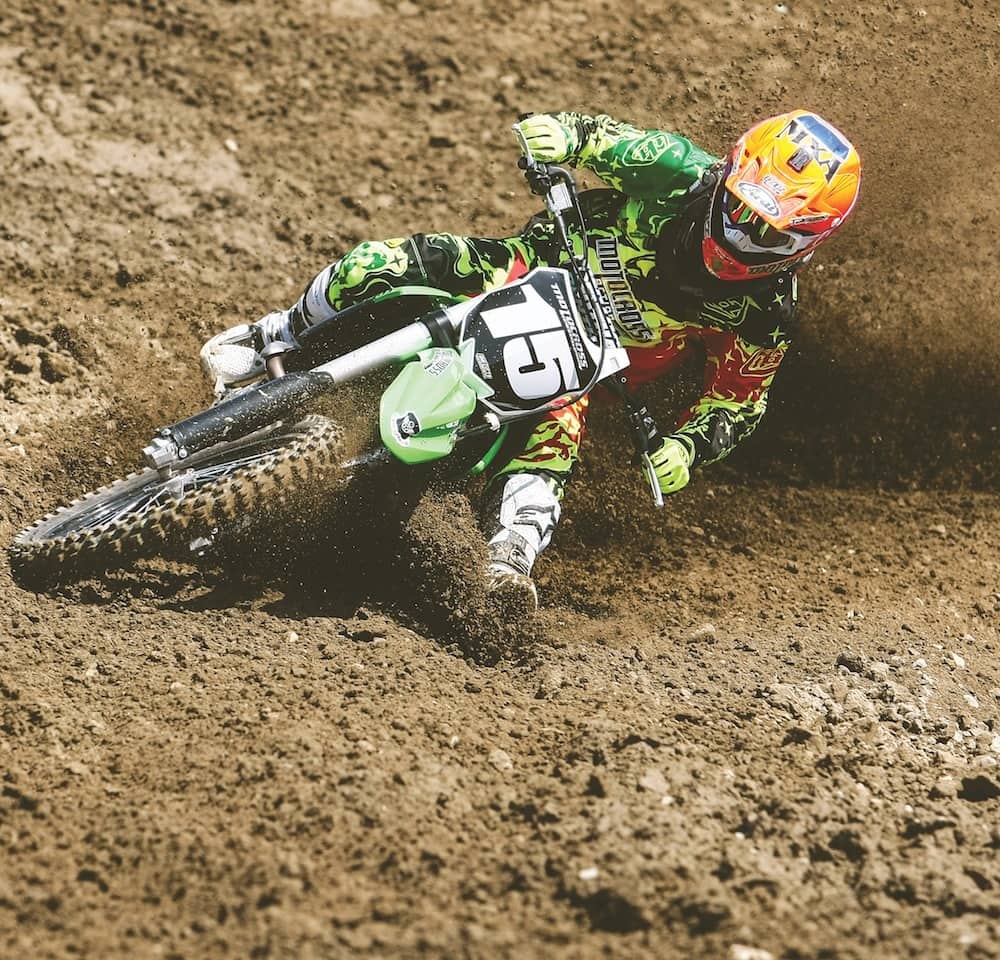MXA’S 2015 KAWASAKI KX250F MOTOCROSS TEST: GREAT?
Q: FIRST AND FOREMOST, IS THE 2015 KAWASAKI KX250F BETTER THAN THE 2014 KX250F?
A: Yes. The KX250F has been king of the 250 four-stroke heap for three years running, and Kawasaki continues to make improvements. The 2015 model isn’t all new, but the MXA wrecking crew has learned over time that a good machine that receives modest revisions often outperforms bikes that are new from the ground up. We’re pleased with the 2015 KX250F and the direction that Kawasaki’s engineers took, although there’s one subpar area that continues to tarnish an otherwise sterling reputation.
Q: WHAT CHANGES DID KAWASAKI MAKE TO THE 2015 KX250F?
A: The list of updates is rather minimal, but the KX250F is well-served by these changes.
(1) Engine. Kawasaki borrowed the Bridge Box piston from the factory race bikes. It is stronger and lighter for increased reliability. We can’t remember how many Bridge Box revisions there have been since 2010, but this one is the latest. The piston design has a thicker under-surface and thicker reinforcing external ribs, which add 3 grams to the piston. Conversely, the piston pin is 3 grams lighter to maintain consistency in the piston assembly weight.
(2) Exhaust. The KX250F comes with an asymmetrical resonance chamber built into the head pipe (to reduce sound to comply with the AMA’s 94-decibel Amateur mandate). The head pipe is also shorter to enhance low-end power, and the KX250F uses the KX450F’s high-volume muffler for improved centralization of mass and increased top-end power. Note that last year’s exhaust system will fit on the 2015 model.

(3) ECU. The ECU system has a new magneto rotor with greater inertia to match the increased acceleration performance. The standard rotor now weighs 9.5 kg/cm, which is up from 9 kg/cm on last year’s bike. Kawasaki sells optional generator rotors (in a lighter 8.5 kg/cm option or a slightly heavier 9 kg/cm).
(4) Injectors. Kawasaki is the only manufacturer to utilize two fuel injectors. It is called Dual Fuel Injection (DFI). For 2015, the 12-hole downstream injector disperses a finer 120-micrometer droplet size, while the upstream injector maintains its previous 75-micrometer droplet pattern. The finer downstream droplet size equates to a boost in power, particularly in the low end and midrange.
(5) Suspension. The Showa Separate Function Fork (SFF) has new valving. Keep in mind that these are not air forks; instead, they have a coil spring in the right fork leg and oil damping in the left leg. Showa’s SFF forks have a super-hard titanium coating on the inner fork tubes, green-anodized caps and a new silver finish on the outer fork tube. As for the Showa shock, there are firmer settings. Although not new, the Kashima coating on the piggyback cylinder reduces friction, resists abrasions and helps smooth out the suspension action. Additionally, the shock spring is now green to match the other color accents on the KX250F.
(6) Axles. In an effort to shave weight, Kawasaki changed the wall thickness on the front and rear axles while maintaining the same outer diameter. They were able to cut 31 grams out of the front axle and 32 grams from the rear axle.
(7) Styling. The 2015 KX250F comes with new factory-style graphics, plus green engine plugs, oil cap, generator cover plugs, as well as green alumite suspension adjusters and black alumite wheels. The shock body has also been colored black for a works-bike look.
(8) Rear axle nut. We’re extremely pleased to report that Kawasaki has finally upgraded to a self-locking rear axle nut. It maintains tightness without requiring a cotter key.
(9) Front brake. Kawasaki has at last beefed up its front brake, upgrading to a 270mm, oversized, petal-shaped, Braking front brake rotor. It replaces last year’s 250mm front rotor. It is paired with a 240mm Braking rear rotor.
(10) Ergonomics. Several of the comforts afforded to the KX450F have trickled down to the 2015 KX250F. The bike now comes with a four-position upper triple clamp with two sets of handlebar mount slots. These offer the rider the choice of four bar positions, including 25mm forward, 15mm forward, standard or 10mm back. Plus, the KX250F has two-position, adjustable footpeg brackets, which can be lowered by 5mm on the frame.
(11) Subframe. The aluminum perimeter frame has been updated in order to accommodate the adjustable footpeg mounts. A new rear subframe is 50 grams lighter for optimized mass centralization. This was accomplished by decreasing the subframe’s inner thickness by 0.2mm.

Q: WHAT IS THE MOST IMPORTANT UPDATE THAT KAWASAKI MADE TO THE KX250F?
A: At the risk of sounding fickle, MXA test riders loved that Kawasaki finally addressed some of the woes that long plagued the KX250F. Although basic, the larger Braking front brake rotor is a considerable improvement over the antiquated front brake that came standard in the past. The self-locking rear axle nut is also a treasured upgrade, because we were sick of dealing with the pesky cotter key. Four-position handlebar mounts are an advantage for taller riders, as are the adjustable footpegs. Overall, the combination of 2015 updates made a big difference. Testers could easily hop on the 2015 KX250F and feel comfortable right away. There weren’t any peccadilloes that left a bad taste in our mouths. If we had to pick a favorite update, we’d choose the larger front brake rotor, as it provides progressive stopping feel at the lever.
Q: WHY DIDN’T THE 2015 KX250F RECEIVE SHOWA’S TRIPLE CHAMBER AIR FORK?
A: The big news on the 2015 KX450F is the switch from Kayaba Pneumatic Spring Forks (PSF) to Showa Separate Function Fork Triple Air Chamber (SFF TAC) technology. Air is the new frontier in suspension development, and Kawasaki was one of the first manufacturers to embrace it with the KX450F. So, why doesn’t the KX250F come equipped with TAC forks? It’s all about the Benjamins, baby. Manufacturers work in cycles when feeding new technology into their product lines. The KX450F, Kawasaki’s flagship offering in the motocross sector, typically receives the latest and greatest updates. And so it goes for 2015. Although the KX250F isn’t quite the redheaded stepchild in the Kawasaki lineup, it is leapfrogged from time to time. The 2015 KX250F boasts improvements, but they aren’t earth-shattering updates that will make the public swoon like the buzz of Triple Air Chamber forks.

Q: ARE WE STILL OPPOSED TO LAUNCH CONTROL ON THE KX250F?
A: Yes. Believe us, we tried to keep an open mind about Kawasaki’s patented Launch Control, but it doesn’t make much sense to mute a 250 four-stroke engine off the starting line. We accept it on the KX450F, but there is a 14-horsepower difference between the two bikes. As powerful as the KX250F is, Launch Control isn’t the answer for preventing rear wheelspin off a starting pad. All of our testers vastly preferred to meter the power and control wheelspin with clutch technique. We think Launch Control does serve a purpose on the KX250F, but only for a very narrow audience. The benefactor? A neophyte, ham-fisted rider with terrible starting skills. Fortunately, Launch Control doesn’t detract from the KX250F; it is merely an extraneous button cluttering the handlebars.
Q: WHAT IS THE BEST ATTRIBUTE OF THE 2015 KX250F?
A: The engine bar none. The potent powerband is the primary reason the KX250F has won MXA’s illustrious “250 Four-Stroke Shootout” for three years running. In fact, only twice since 2006 has the KX250F not been in the top spot. Kawasaki has long known the secret to 250 four-stroke success: build a race-ready engine and surround it with a chassis and suspension package that is, at the very least, workmanlike.
Although it might appear that MXA test riders view the KX250F with rose-colored glasses, that’s not the case. We’ve long grumbled about the quirky handling and pedestrian suspension; however, we’re always captivated by the do-everything powerband. It has gusto off idle, but not enough to overwhelm. Midrange power is plentiful, with enough hit and pull to make any skill level rider appreciate the output. There are bikes in the 250 class that produce more peak horsepower (read KTM 250SXF), but none that ramp up with such broadness and ease in transition. It is the very essence of what a 250 four-stroke powerband should be. The KX250F engine fills the gaps and has enough oomph to knock it out of the park.

Q: WHAT IS THE WORST ATTRIBUTE OF THE 2015 KX250F?
A: Here’s what we wrote about last year’s model: “The KX250F has always handled like a girl getting ready for a blind date—confused, somewhat ditzy, unsure and even a bit nervous. Handling is not one of the standout traits of the KX250F.” And so it goes with the 2015 KX250F. Sooner or later Kawasaki will need to face the fact that the KX250F handles like a tug boat. In the past, we’ve forgiven Kawasaki for its cornering trespasses, but that ship has finally sailed. We believe that properly placed horsepower is the most important attribute of a 250cc motocross bike, but it can’t be the only thing, especially now that the Yamaha YZ250F has closed the horsepower gap.
The 2015 KX250F is not the best-handling bike in the class. Its cornering methodology is to let the rear end do most of the work, while the front end stands up in the center of the turn. MXA test riders toil to achieve perfect chassis balance on every bike, but the KX250F is never precise. We’ve tried all the combos. More weight on the front yielded a bigger contact patch, with the caveat that the front tire hunted and pecked more. Conversely, going the opposite direction by lowering the race sag to slacken the head angle yielded no favors from the front end. Instead, the front end pushed more during transition. With time and effort, every MXA test rider came to his own solution. The real solution is at the Kawasaki factory level.
Q: WHAT CHANGES CAN BE MADE TO IMPROVE THE KX250F?
A: MXA test riders are very good at their jobs, and one of their jobs is to find chinks in a bike’s armor. Here are the KX250F chinks.
(1) Triple clamps. Don’t be satisfied with the KX250F until you achieve the correct chassis balance and dial in the suspension. We spent hours trying to find a favorable setting. Eventually, we installed a set of 22mm offset triple clamps. The different head angle makes cornering more precise and doesn’t have any trade-offs (except to your bank account).
(2) Pull rod. When the first two changes made to the 2015 KX250F revolve around handling, you know that something is amiss. In stock trim, the shock wallows under acceleration and has a tendency to wander. A longer pull rod ramps up the rising rate so that the shock doesn’t blow so quickly through the initial part of the stroke. Plus, it lowers the seat height. It’s a wise investment.
(3) Clutch. The strain put on the clutch assembly by hard riding is too great over an extended run-time, resulting in a slipping clutch that hinders forward advancement. Stiffer clutch springs are a must, or buy a Hinson clutch (www.hinsonracing.com) if you never want to worry about clutch problems again.

(4) Couplers. Upon purchasing a 2015 KX250F, you should be given a care package that includes two additional plug-in couplers. The green (standard) coupler is attached to the wiring harness on the right side of the head tube. The white (soft terrain) coupler is MXA’s favorite, as it advances the ignition for a more aggressive feel. The black (hard terrain) coupler is meant for rock-hard, slippery tracks where less wheelspin is desired. In most circumstances, we opt for the white coupler, which takes less than 30 seconds to install.
Q: WHAT DID WE HATE?
A: The hate list:
(1) Shifting. Kawasaki has gone ’round and ’round trying to improve the shifting traits on the KX250F. Unfortunately, the bike refuses to shift under a heavy load. Use the clutch or breathe the engine to get it to upshift at speed.
(2) Clutch. At the very least, install stiffer aftermarket clutch springs.
(3) Chain guide. The stock chain guide will get chewed up faster than a single-flipper sea lion in the Great Barrier Reef. We suggest contacting T.M. Designworks at (541) 772-4161 to buy its indestructible chain guide kit.
(4) Grips. You’ll need to have Lilliputian-sized hands in order to fit on the minuscule KX250F grips. The grips are small and hard (just like your ex-girlfriend’s cheating heart).
(5) Handling. The KX250F doesn’t corner with precision. It’s possible to improve the handling characteristics, but not without spending money.

Q: WHAT DID WE LIKE?
A: The like list:
(1) Engine. It rocks and it rolls. The KX250F powerband is blindingly fast and inspires confidence for all who dare to twist the throttle.
(2) Upstream injector. The main reason the engine is so broad is due to the secondary, upstream injector, which delivers fuel at a progressive rate as the engine rises from 7000 to 13,000 rpm. It’s the future.
(3) Couplers. Riding a loamy track? Plug in the white coupler. Are you racing across hardpack? Simply install the black coupler. It’s that easy.
(4) Upgrades. The four-position bar mounts and adjustable footpeg height will cater to taller riders. This is a bike that fits all kinds.
(5) Rear axle nut. Hallelujah! Our prayers have finally been answered! Kawasaki pitched the cotter key for a self-locking rear axle nut. The new axle bolt is proof that the simple things in life mean the most.
Q: WHAT DO WE REALLY THINK?
A: The 2015 Kawasaki KX250F is a brilliant motocross bike, thanks mostly to an unbelievably broad engine. Improvements in the ergonomics and braking power are a plus. After those highlights, the 2015 KX250F receives mediocre marks in suspension, shifting, clutch and overall durability. Worse yet, the KX250F gets a D in handling characteristics. It’s our hope that Kawasaki improves the handling traits for 2016, just not at the expense of the luscious powerband.

MXA KAWASAKI KX250F SETUP SPECS
This is how we set up our 2015 Kawasaki KX250F for racing. We offer it as a guide to help you get your own bike dialed in.
SHOWA SFF FORK SETTINGS
The 48mm Showa SFF has come standard on the KX250F since 2011. The baseline settings have improved slightly every year, as Kawasaki has focused on targeting a wider range of riders. What’s particularly unique about the SFF fork is that the preload can be adjusted to either raise or lower the ride height. Ride height is very important, as it determines the handling traits. Too much ride height yields a vague feeling at turn-in. Too little ride height causes the front end to drift. The preload adjuster has 40 clicks.
For hardcore racing, we recommend this fork setup for the 2015 Kawasaki KX250F (stock specs are in parentheses):
Spring rate: 0.96 Nm
Oil height: 300cc in left leg, 223cc in right leg
Compression: 6 clicks out (7 clicks out)
Rebound: 11 clicks out (10 clicks out)
Preload adjuster: 25 clicks in (8 clicks in)
Fork leg height: 5mm up
Notes: Use the preload adjuster and fork-leg height to your advantage. Find the best balance between the forks and shock before dialing in the clickers. Some testers preferred to run the preload adjuster farther in. Kawasaki does sell optional spring rates (0.92 Nm or 1.0 Nm). Note that there are air-bleeder screws at the top of each fork leg.
SHOWA UNI-TRAK SHOCK SETTINGS
There’s a delicate dance that happens between the Uni-Trak shock and the SFF forks. Placing too much emphasis on the front end yields a sensation of oversteer at turn-in; but, if the shock handles most of the weight, the front tire unloads and the bike stands up. Regardless, the shock wallows under a heavy load, and straight-line stability can be compromised with a shoddy setup. We’ve discovered that the ultimate solution is to bite the bullet and buy a longer pull rod. It stiffens up the initial part of the shock’s stroke and keeps the rear from diving like a professional soccer player.
For hardcore racing, we recommend this shock setup for the 2015 Kawasaki KX250F (stock specs are in parentheses):
Spring rate: 5.3 Nm
Race sag: 100mm
Hi-compression: 2 turns out
Lo-compression: 8 clicks out (11 clicks out)
Rebound: 13 clicks out (14 clicks out)
Notes: These settings are geared toward a heavier rider (170-plus pounds). We think that the KX250F works best with the low-speed compression turned in while using the high-speed to adjust the ride height at speed. There are four additional spring rates available from Kawasaki: 4.7, 4.9, 5.1 or 5.5 Nm.

Click here to subscribe to MXA: https://hi-torque.com/motocrossaction







Comments are closed.